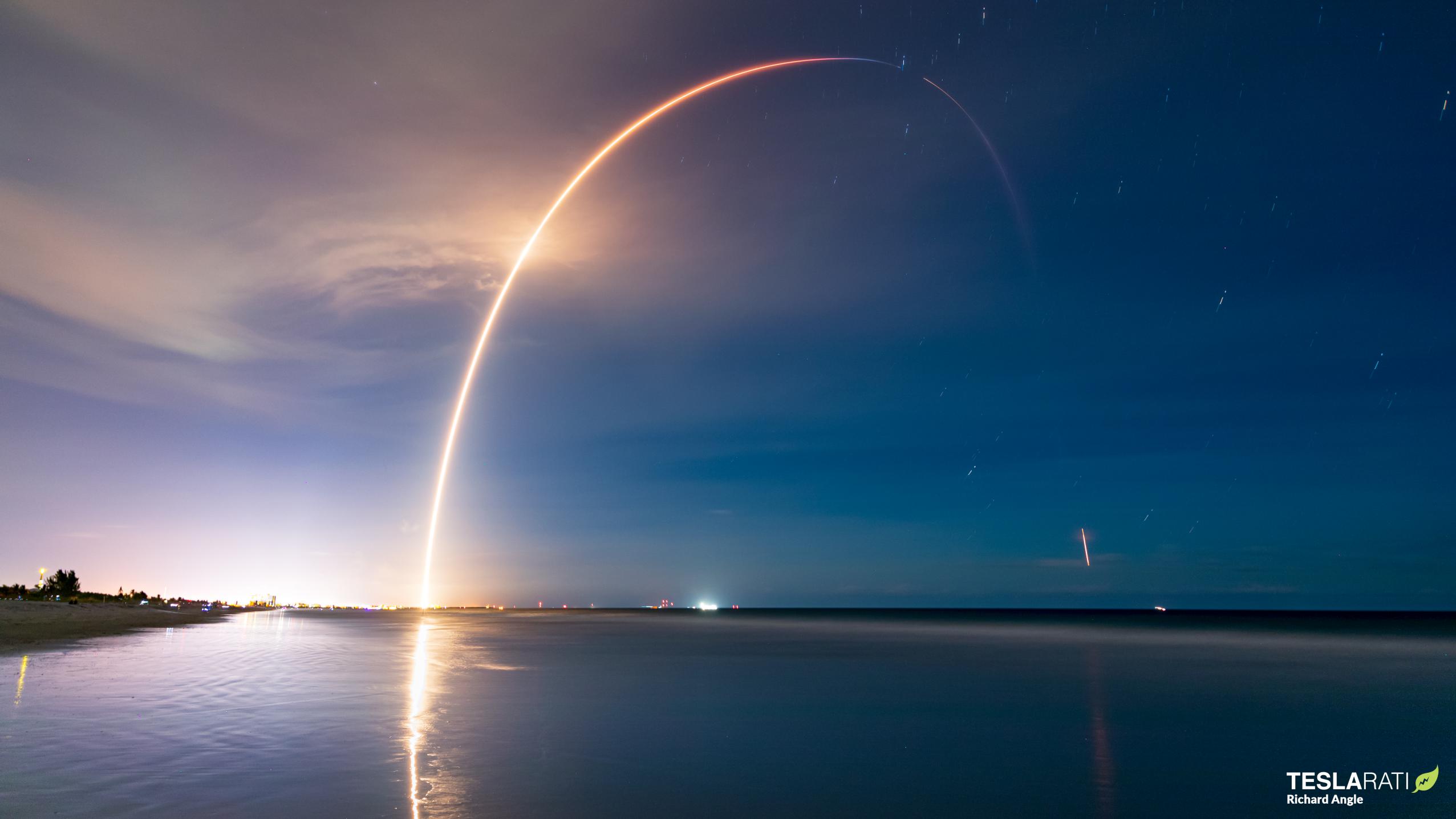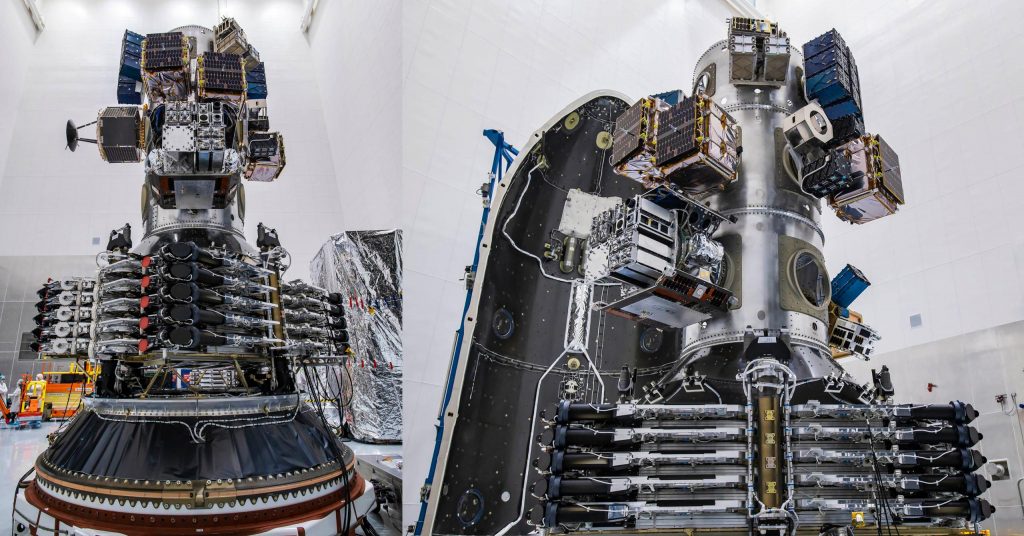

News
SpaceX sends Starlink satellites, Boeing demonstrator into orbit on 40th launch of 2022
SpaceX has completed its 40th Falcon 9 launch of 2022, delivering a new batch of Starlink satellites and Boeing demonstration satellite into orbit.
Right on schedule, Falcon 9 lifted off from SpaceX’s Cape Canaveral Space Force Station (CCSFS) LC-40 pad at 10:09 pm EDT, Sunday, September 4th. The rocket’s reused booster and fairing and new upper stage performed as expected, continuing Falcon 9’s unprecedented streak of 149 successful launches. Flying for the seventh time overall, former Falcon Heavy booster B1052 performed flawlessly after a quick 31-day turnaround and touched down on SpaceX drone ship Just Read The Instructions’ (JRTI) deck several hundred miles downrange less than nine minutes after liftoff.
Flying for the fourth and fifth times, the Starlink 4-20 mission’s Falcon 9 fairing halves also worked as expected on ascent. SpaceX does not discuss fairing recovery but both halves likely deployed parafoils after reenter Earth’s atmosphere and gently splashed down in the Atlantic Ocean. SpaceX support ship Doug will eventually fish them out of the water for reuse.
Not merely a Starlink mission, Starlink 4-20 was SpaceX’s sixth Starlink rideshare. Sitting atop the stack of 51 Starlink V1.5 satellites was an experimental spacecraft built by Spaceflight Inc. Known as Sherpa-LTC2, Spaceflight and partner Astro Digital turned the orbital transfer vehicle (space tug) into a satellite for customer Boeing. The purpose: carry and test a prototype communications payload built by Astro Digital and designed to verify new V-band communications technologies for a planned constellation of Boeing satellites in Low Earth Orbit (LEO).
The US Federal Communications Commission (FCC) approved Boeing’s plans for a 147-satellite V-band constellation in November 2021. It’s unclear what the purpose of the constellation would be or if Boeing already has customers or partners lined up. The prototype spacecraft built by Spaceflight and Astro Digital – known as Varuna in recent FCC filings – will be crucial for determining the constellation’s future. Boeing wants to use a swath of spectrum known as the V-band that has a higher frequency than the Ku and Ka bands commonly used by most other communications satellites. A higher frequency could mean higher connection speeds and more available bandwidth, but V-band radio waves tend to struggle to pierce through rain and other adverse weather conditions.
Varuna should help Boeing fully determine whether that interference is a showstopper or something that can be managed. Boeing applied for an FCC license for its V-band constellation in 2017. It’s unclear whether a lack of interest on Boeing’s part or problems with the application caused the process to take as long as it did.
Varuna was successfully deployed from Falcon 9 a bit less than 50 minutes later in a mostly circular orbit 316 kilometers (196 mi) above Earth’s surface. Outfitted with a propulsion system designed by startup Benchmark Space, Sherpa-LTC2 is meant to eventually raise itself into an operational orbit around 1050 kilometers (~650 mi), where the V-band payload can be tested at the same altitude as Boeing’s planned constellation.

20 minutes after Varuna’s deployment, Falcon 9’s upper stage – spinning end over end – released all 51 Starlink satellites at once, completing the payload portion of the mission. As always, the upper stage will likely perform a deorbit burn within a few hours of liftoff and should reenter Earth’s atmosphere not long after, ensuring that the only space debris produced by the mission is the Varuna deployment mechanism and a set of four benign Starlink ‘tensioning rods’ that should reenter in about two months.
Starlink 4-20 was SpaceX’s 40th launch of 2022 and 50th launch in 12 months. According to Next Spaceflight, the company has plans for at least two more Starlink launches within the next eight days. Starlink 4-2, another rideshare mission, is scheduled no earlier than September 10th, while Starlink 4-34 could launch on September 12th.
News
Tesla begins Robotaxi certification push in Arizona: report
Tesla seems serious about expanding its Robotaxi service to several states in the coming months.

Tesla has initiated discussions with Arizona transportation regulators to certify its driverless Robotaxi service in the state, as per a recent report from Bloomberg News. The move follows Tesla’s launch of its Robotaxi pilot program in Austin, Texas, as well as CEO Elon Musk’s recent comments about the service’s expansion in the Bay Area.
The Arizona Department of Transportation confirmed to Bloomberg that Tesla has reached out to begin the certification process for autonomous ride-sharing operations in the state. While details remain limited, the outreach suggests that Tesla is serious about expanding its driverless Robotaxi service to several territories in the coming months.
The Arizona development comes as Tesla prepares to expand its service area in Austin this weekend, as per CEO Elon Musk in a post on X. Musk also stated that Tesla is targeting the San Francisco Bay Area as its next major market, with a potential launch “in a month or two,” pending regulatory approvals.
Tesla first launched its autonomous ride-hailing program on June 22 in Austin with a small fleet of Model Y vehicles, accompanied by a Tesla employee in the passenger seat to monitor safety. While still classified as a test, Musk has said the program will expand to about 1,000 vehicles in the coming months. Tesla will later upgrade its Robotaxi fleet with the Cyercab, a two-seater that is designed without a steering wheel.
Sightings of Cybercab castings around the Giga Texas complex suggests that Tesla may be ramping the initial trial production of the self-driving two-seater. Tesla, for its part, has noted in the past that volume production of the Cybercab is expected to start sometime next year.
In California, Tesla has already applied for a transportation charter-party carrier permit from the state’s Public Utilities Commission. The company is reportedly taking a phased approach to operating in California, with the Robotaxi service starting with pre-arranged rides for employees in vehicles with safety drivers.
News
Tesla sets November 6 date for 2025 Annual Shareholder Meeting
The automaker announced the date on Thursday in a Form 8-K.

Tesla has scheduled its 2025 annual shareholder meeting for November 6, addressing investor concerns that the company was nearing a legal deadline to hold the event.
The automaker announced the date on Thursday in a Form 8-K submitted to the United States Securities and Exchange Commission (SEC). The company also listed a new proposal submission deadline of July 31 for items to be included in the proxy statement.
Tesla’s announcement followed calls from a group of 27 shareholders, including the leaders of large public pension funds, which urged Tesla’s board to formally set the meeting date, as noted in a report from The Wall Street Journal.
The group noted that under Texas law, where Tesla is now incorporated, companies must hold annual meetings within 13 months of the last one if requested by shareholders. Tesla’s previous annual shareholder meeting was held on June 13, 2024, which placed the July 13 deadline in focus.
Tesla originally stated in its 2024 annual report that it would file its proxy statement by the end of April. However, an amended filing on April 30 indicated that the Board of Directors had not yet finalized a meeting date, at least at the time.
The April filing also confirmed that Tesla’s board had formed a special committee to evaluate certain matters related to CEO Elon Musk’s compensation plan. Musk’s CEO performance award remains at the center of a lengthy legal dispute in Delaware, Tesla’s former state of incorporation.
Due to the aftermath of Musk’s legal dispute about his compensation plan in Delaware, he has not been paid for his work at Tesla for several years. Musk, for his part, has noted that he is more concerned about his voting stake in Tesla than his actual salary.
At last year’s annual meeting, TSLA shareholders voted to reapprove Elon Musk’s compensation plan and ratified Tesla’s decision to relocate its legal domicile from Delaware to Texas.
Elon Musk
Grok coming to Tesla vehicles next week “at the latest:” Elon Musk
Grok’s rollout to Tesla vehicles is expected to begin next week at the latest.

Elon Musk announced on Thursday that Grok, the large language model developed by his startup xAI, will soon be available in Tesla vehicles. Grok’s rollout to Tesla vehicles is expected to begin next week at the latest, further deepening the ties between the two Elon Musk-led companies.
Tesla–xAI synergy
Musk confirmed the news on X shortly after livestreaming the release of Grok 4, xAI’s latest large language model. “Grok is coming to Tesla vehicles very soon. Next week at the latest,” Musk wrote in a post on social media platform X.
During the livestream, Musk and several members of the xAI team highlighted several upgrades to Grok 4’s voice capabilities and performance metrics, positioning the LLM as competitive with top-tier models from OpenAI and Google.
The in-vehicle integration of Grok marks a new chapter in Tesla’s AI development. While Tesla has long relied on in-house systems for autonomous driving and energy optimization, Grok’s integration would introduce conversational AI directly into its vehicles’ user experience. This integration could potentially improve customer interaction inside Tesla vehicles.
xAI and Tesla’s collaborative footprint
Grok’s upcoming rollout to Tesla vehicles adds to a growing business relationship between Tesla and xAI. Earlier this year, Tesla disclosed that it generated $198.3 million in revenue from commercial, consulting, and support agreements with xAI, as noted in a report from Bloomberg News. A large portion of that amount, however, came from the sale of Megapack energy storage systems to the artificial intelligence startup.
In July 2023, Musk polled X users about whether Tesla should invest $5 billion in xAI. While no formal investment has been made so far, 68% of poll participants voted yes, and Musk has since stated that the idea would be discussed with Tesla’s board.
-

 Elon Musk1 week ago
Elon Musk1 week agoTesla investors will be shocked by Jim Cramer’s latest assessment
-

 Elon Musk3 days ago
Elon Musk3 days agoElon Musk confirms Grok 4 launch on July 9 with livestream event
-

 Elon Musk16 hours ago
Elon Musk16 hours agoxAI launches Grok 4 with new $300/month SuperGrok Heavy subscription
-

 News7 days ago
News7 days agoTesla Model 3 ranks as the safest new car in Europe for 2025, per Euro NCAP tests
-

 Elon Musk2 weeks ago
Elon Musk2 weeks agoA Tesla just delivered itself to a customer autonomously, Elon Musk confirms
-

 Elon Musk1 week ago
Elon Musk1 week agoxAI’s Memphis data center receives air permit despite community criticism
-

 Elon Musk2 weeks ago
Elon Musk2 weeks agoTesla’s Omead Afshar, known as Elon Musk’s right-hand man, leaves company: reports
-

 News2 weeks ago
News2 weeks agoXiaomi CEO congratulates Tesla on first FSD delivery: “We have to continue learning!”

















